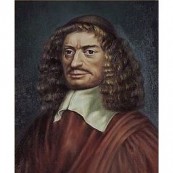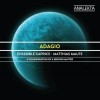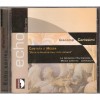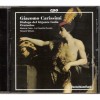Composers
Giacomo Carissimi (baptized April 18, 1605 – January 12, 1674) was an Italian composer, one of the most celebrated masters of the early Baroque, or, more accurately, the Roman School of music.
is exact birthdate is not known, but it was probably in 1604 or 1605 in Marino, near Rome.
Of his early life almost nothing is known. His father was a barrel maker, and at the age of twenty Giacomo became chapel-master at Assisi. In 1628 he obtained the same position at the church of Sant'Apollinare belonging to the Collegium Germanicum in Rome, which he held until his death. This was despite him receiving several offers to work in very prominent establishments, including an offer to take over from Claudio Monteverdi at Saint Mark's in Venice. In 1637 he was ordained a priest. He seems never to have left Italy.
He died in Rome in 1674.
His successor as maestro di cappella at the Collegio Germanico in 1686, describes him as: very frugal in his domestic affairs, very noble manners towards friends and acquaintances, tall, thin, and prone to melancholy.[1][full citation needed]
The great achievements generally ascribed to him are the further development of the recitative, introduced by Monteverdi, and of infinite importance in the history of dramatic music; the further development of the chamber-cantata, by which Carissimi superseded the concertato madrigals which had themselves replaced the madrigals of the late Renaissance; and the development of the oratorio, of which he was the first significant composer.
His position in the history of church music and vocal chamber music is somewhat similar to that of Cavalli in the history of opera. While Luigi Rossi was his predecessor in developing the chamber-cantata, Carissimi was the composer who first made this form the vehicle for the most intellectual style of chamber-music, a function which it continued to perform until the death of Alessandro Scarlatti, Astorga and Marcello.
Carissimi is also noted as one of the first composers of oratorios, with Jephte probably the best known, as well as Jonas; this work and others are important as definitely establishing the form of oratorio unaccompanied by dramatic action, which maintained its hold for two hundred years. The name comes from their presentation at the Oratory of Santissimo Crocifisso in Rome. He also may claim the merit of having given greater variety and interest to the instrumental accompaniments of vocal compositions. Dr Burney and Sir John Hawkins published specimens of his compositions in their works on the history of music; and Dr Aldrich collected an almost complete set of his compositions, at present in the library of Christ Church, Oxford. The British Museum also possesses numerous works by Carissimi. Most of his oratorios are in the Bibliothèque Nationale at Paris.
Carissimi was active at the time when secular music was about to usurp the dominance of sacred music in Italy; the change was decisive, and permanent. When he began composing, the influence of the previous generations of Roman composers was still heavy (for instance, the style of Palestrina); and when his career came to a close the operatic forms, as well as the instrumental secular forms, were predominant. In addition, Carissimi was important as a teacher, and his influence spread far into Germany and France: much of the musical style of Charpentier, for example, is dependent on the earlier composer.
Recently Added
Biography
Giacomo Carissimi (baptized April 18, 1605 – January 12, 1674) was an Italian composer, one of the most celebrated masters of the early Baroque, or, more accurately, the Roman School of music.
is exact birthdate is not known, but it was probably in 1604 or 1605 in Marino, near Rome.
Of his early life almost nothing is known. His father was a barrel maker, and at the age of twenty Giacomo became chapel-master at Assisi. In 1628 he obtained the same position at the church of Sant'Apollinare belonging to the Collegium Germanicum in Rome, which he held until his death. This was despite him receiving several offers to work in very prominent establishments, including an offer to take over from Claudio Monteverdi at Saint Mark's in Venice. In 1637 he was ordained a priest. He seems never to have left Italy.
He died in Rome in 1674.
His successor as maestro di cappella at the Collegio Germanico in 1686, describes him as: very frugal in his domestic affairs, very noble manners towards friends and acquaintances, tall, thin, and prone to melancholy.[1][full citation needed]
The great achievements generally ascribed to him are the further development of the recitative, introduced by Monteverdi, and of infinite importance in the history of dramatic music; the further development of the chamber-cantata, by which Carissimi superseded the concertato madrigals which had themselves replaced the madrigals of the late Renaissance; and the development of the oratorio, of which he was the first significant composer.
His position in the history of church music and vocal chamber music is somewhat similar to that of Cavalli in the history of opera. While Luigi Rossi was his predecessor in developing the chamber-cantata, Carissimi was the composer who first made this form the vehicle for the most intellectual style of chamber-music, a function which it continued to perform until the death of Alessandro Scarlatti, Astorga and Marcello.
Carissimi is also noted as one of the first composers of oratorios, with Jephte probably the best known, as well as Jonas; this work and others are important as definitely establishing the form of oratorio unaccompanied by dramatic action, which maintained its hold for two hundred years. The name comes from their presentation at the Oratory of Santissimo Crocifisso in Rome. He also may claim the merit of having given greater variety and interest to the instrumental accompaniments of vocal compositions. Dr Burney and Sir John Hawkins published specimens of his compositions in their works on the history of music; and Dr Aldrich collected an almost complete set of his compositions, at present in the library of Christ Church, Oxford. The British Museum also possesses numerous works by Carissimi. Most of his oratorios are in the Bibliothèque Nationale at Paris.
Carissimi was active at the time when secular music was about to usurp the dominance of sacred music in Italy; the change was decisive, and permanent. When he began composing, the influence of the previous generations of Roman composers was still heavy (for instance, the style of Palestrina); and when his career came to a close the operatic forms, as well as the instrumental secular forms, were predominant. In addition, Carissimi was important as a teacher, and his influence spread far into Germany and France: much of the musical style of Charpentier, for example, is dependent on the earlier composer.


















